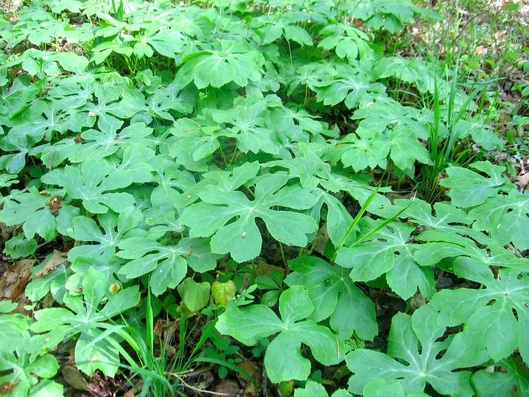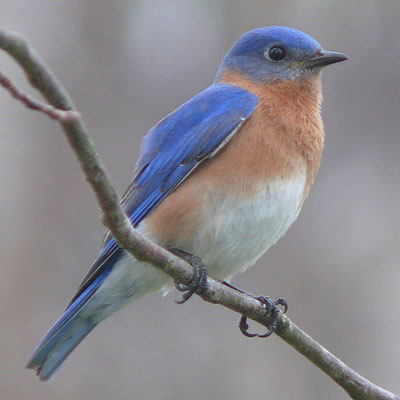Native Plants & Wildlife
Please do not disturb the native plants and wildlife. Although some plants are edible, they are not to be consumed. Below is our gallery, if you would like to submit your photos of the park's flora and fauna email them to [email protected].
Below is just a few of the native plants and wildlife you'll find in the Farmington Nature Park.
Below is just a few of the native plants and wildlife you'll find in the Farmington Nature Park.
Great Blue Heron
Notable features include red-brown thighs, the neck and feathers are rusty-gray, with black and white streaking down the front; the head is paler, with a nearly white face, and a pair of black plumes runs from just above the eye to the back of the head. The feathers on the lower neck are long and plume-like and plumes can be seen on the lower back at the start of breeding season. The bill is dull yellowish, becoming orange briefly at the start of the breeding season, and the lower legs gray, also becoming orange at the start of the breeding season.
Rabbits
Below is an image of a rabbit's nest found on the grounds. A rabbit's nest can be identified by its common construction of grass and fur. Tall grass is tightly woven into clumps of the mother's fur, providing insulation and camouflage. This covers the burrow underneath.
Red-bellied Woodpecker
The reddish tinge on the belly that gives the bird its name is difficult to see in field identification, but the coloring on the head is noticeable. Adults are mainly light gray on the face and underparts; they have black and white barred patterns on their back, wings and tail. Adult males have a red head going from the bill to the nape; females have a red patch on the nape and another above the bill.
Beavers
Evidence suggests Cedar Creek is a beaver habitat. Keep an eye out for beaver escape holes and tree stumps chewed to a point.
Periwinkle
Common periwinkle, is a perennial evergreen ground cover that is winter hardy.
periwinkle seldom exceeds a height of 6 inches although runners may trail long distances on the ground. The runners root at the node under moist conditions. The thick glossy leaves form a good ground cover. Small blue flowers occur indeterminately from April to September. Common periwinkle is particularly desirable as an attractive evergreen ground cover in mild climates. It is valuable on yards, banks, or odd areas as a low maintenance ground cover.
Periwinkle has a long magical history and was a common ingredient in charms and potions. Its presence was believed to discourage evil spirits and keep your home safe from ghostly interlopers. In olden times, garlands of periwinkle were placed on the coffins of dead children, and in France it is considered an herb of friendship. In forests it is often encountered in the vicinity of old graveyards, which is why it is sometimes called "graveyard grass". Periwinkle has medicinal applications as a treatment for both leukemia and diabetes, but it's not for the do-it-yourself herbalist, so don't use it in your home remedies instead, it is best used for decoration only.
periwinkle seldom exceeds a height of 6 inches although runners may trail long distances on the ground. The runners root at the node under moist conditions. The thick glossy leaves form a good ground cover. Small blue flowers occur indeterminately from April to September. Common periwinkle is particularly desirable as an attractive evergreen ground cover in mild climates. It is valuable on yards, banks, or odd areas as a low maintenance ground cover.
Periwinkle has a long magical history and was a common ingredient in charms and potions. Its presence was believed to discourage evil spirits and keep your home safe from ghostly interlopers. In olden times, garlands of periwinkle were placed on the coffins of dead children, and in France it is considered an herb of friendship. In forests it is often encountered in the vicinity of old graveyards, which is why it is sometimes called "graveyard grass". Periwinkle has medicinal applications as a treatment for both leukemia and diabetes, but it's not for the do-it-yourself herbalist, so don't use it in your home remedies instead, it is best used for decoration only.
Eastern Redbud, Judas Tree

This species has several varieties recognized in the U.S. and is native to the eastern and south-central United States, southward to Texas. Eastern Redbud occurs in the forest understory in moist rich woods, along the banks of streams, in ravines, on bluffs, in open rocky woods, and abandoned farmlands. The trees produce hundreds of small pink pea flowers in the very early spring, even before other trees have leafed out. The bright magenta pink to lilac flowers, appear in small clusters, primarily on older stems.
Many birds, including bobwhite quails, eat the seeds. White-tailed deer are among the animals that browse the foliage. Honeybees visit the blossoms. The Alabama, Cherokee, Delaware, Kiowa, and Oklahoma were among the Native American tribes that used Eastern Redbud for various purposes. The bark was made into a tea to treat whooping cough. Taking cold infusions of the roots and inner bark treated fevers and congestion. An infusion of the bark was used to treat vomiting and fever. During winters, the plants were used for firewood. Because it is one of the first plants to flower in the spring, the blossoming branches were brought into the homes to “drive winter out.” Children were “fond of eating the blossoms” of Eastern Redbud.
Many birds, including bobwhite quails, eat the seeds. White-tailed deer are among the animals that browse the foliage. Honeybees visit the blossoms. The Alabama, Cherokee, Delaware, Kiowa, and Oklahoma were among the Native American tribes that used Eastern Redbud for various purposes. The bark was made into a tea to treat whooping cough. Taking cold infusions of the roots and inner bark treated fevers and congestion. An infusion of the bark was used to treat vomiting and fever. During winters, the plants were used for firewood. Because it is one of the first plants to flower in the spring, the blossoming branches were brought into the homes to “drive winter out.” Children were “fond of eating the blossoms” of Eastern Redbud.
Toothwart

These sweet little flowers bloom from April to June and grow to about 12". A member of the mustard family, it is typified by a four petal flower which blooms in a cluster on a single stalk above a single pair of toothed stem leaves each divided into three broad leaflets. The presence of this species in a woodlands indicates that its soil has never been plowed under or subjected to heavy construction activities. The nectar of the flowers attracts bees, including honey bees, bumblebees, and Mason bees. The West Virgina White Butterfly lays its eggs on this plant and the larvae feed on it as well.
Toothwort has medicinal and edible properties. The roots are used fresh or dried for toothache, ground and applied to area of pain. Made into a medicinal tea for treatment of colds and congestion, gargle for sore throat, and general spring tonic, Toothwort is said to have a sedative effect. The fresh crushed root is used as a plaster for aches, pains and rheumatism. Dried powdered herb is used as pepper and makes a good seasoning. Fresh edible roots have a crisp texture, hot and peppery it can be eaten in salad, or cooked as pot herb or added to stir fry for flavor. Used as a medicinal herb by some Native American tribes, it is also said that some tribes made a type of mace powder of the root to be blown in the eyes of the enemy to disable them. Dry herb was used as snuff to cause hallucination during some rituals.
Toothwort has medicinal and edible properties. The roots are used fresh or dried for toothache, ground and applied to area of pain. Made into a medicinal tea for treatment of colds and congestion, gargle for sore throat, and general spring tonic, Toothwort is said to have a sedative effect. The fresh crushed root is used as a plaster for aches, pains and rheumatism. Dried powdered herb is used as pepper and makes a good seasoning. Fresh edible roots have a crisp texture, hot and peppery it can be eaten in salad, or cooked as pot herb or added to stir fry for flavor. Used as a medicinal herb by some Native American tribes, it is also said that some tribes made a type of mace powder of the root to be blown in the eyes of the enemy to disable them. Dry herb was used as snuff to cause hallucination during some rituals.
Bluebirds
The park's wetlands are ideal for bird watching. There are several bird houses on the property where you may find these singing animals if you are quiet enough.
Wood Duck
The adult male has distinctive multicolored iridescent plumage and red eyes,with a distinctive white flare down the neck. The less colorful female has a white eye-ring and a whitish throat. Both adults have crested heads.
Spring Beauty
This native perennial plant is about 3-6" tall, consisting of a flowering stem with a pair of opposite cauline leaves and some basal leaves. The flowers open up on warm sunny days, and close during cloudy weather or at night. Blooming occurs from mid to late spring and lasts about a month.
Mahonia
These shrubs have large, pinnate leaves that are about 4–20" long with 5-15 spiny leaflets. They bloom yellow flowers, produce blue-bla in autumn, winter and early spring.
Mayapple

Mayapple (Podophyllum peltatum) is one of the most easily recognizable spring wildflowers by its distinctive foliage. By early to mid-April the unopened, peltate leaves of Mayapple begin to poke through the forest litter resembling a fat green umbrella ready to unfurl. The single-leafed stems will not produce a flower that season.
In the 1800s and early 1900s, Mayapple extract was used as an active ingredient in Carter’s Little Liver Pills; today, it is used as an extract called “Podophyllin” to remove genital warts. American Indians ate the ripe fruits and used a number of medicina preparations including treatments for rheumatism, as a laxative as well as treatment for diarrhea, ulcers, sores, liver and bile problems, hemorrhoids, headaches, diuretic, whooping cough, cholera, pneumonia.
by Marion Lobstein
Some of the information on this page was courtesy of Wikipedia.
In the 1800s and early 1900s, Mayapple extract was used as an active ingredient in Carter’s Little Liver Pills; today, it is used as an extract called “Podophyllin” to remove genital warts. American Indians ate the ripe fruits and used a number of medicina preparations including treatments for rheumatism, as a laxative as well as treatment for diarrhea, ulcers, sores, liver and bile problems, hemorrhoids, headaches, diuretic, whooping cough, cholera, pneumonia.
by Marion Lobstein
Some of the information on this page was courtesy of Wikipedia.














